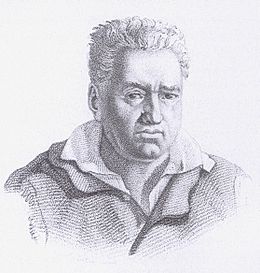François Tourte facts for kids

François Xavier Tourte (1747 – 25 April 1835) was a French bow maker who made a number of significant contributions to the development of the bow of stringed instruments, and is considered to be the most important figure in the development of the modern bow. Because of this, he has often been called the Stradivari of the bow.
Development of the modern bow
Tourte spent eight years as a watchmaker's apprentice before finally becoming an apprentice to his luthier father, Nicolas Pierre Tourte père (c.1700 - 1764). After his father's death, Tourte, in collaboration with the violin virtuoso G. B. Viotti, made important changes in the form of the bow in the Classical period between 1785 and 1790.
Tourte's bows are made from pernambuco wood, the most usual form of wood used on professional bows today. Tourte's bows tended to be heavier than previous models, with more wood at the tip of the bow counterbalanced by a heavier frog (the device connecting the hair to the stick at the end nearest the player's hand).
They generally have a usable hair-length of around 65 cm, and the balance point is 19 cm from the frog. The bows were elegantly fluted through half, or sometimes the whole, of their length. The curve in the wood was created by heating the wood thoroughly and then bending it. Before Tourte, bows had been cut to the desired bend. The final important change credited to Tourte is the screw in the frog (or nut) to moderate the tension in the hair. This propelling and withdrawing screw is found on virtually all modern violin bows. He is also credited with the invention of the spreader block, which fixes the hair of the bow in a flat ribbon, and so prevents tangling.
At the height of his career, a single Tourte bow fetched 15 Louis d'Or. Tourte destroyed any bow that was not entirely faultless before it left his workshop. He never varnished his bows but only rubbed them with pumice powder and oil. The Tourte pattern was followed by Dominique Peccatte, Jacob Eury, Nicolas Maire, François Lupot, Nicolas Maline, Joseph Henry and Jean Pierre Marie Persois.
Quotes
"The French bow maker François-Xavier Tourte, more commonly known as François Tourte or Tourte le jeune, is often referred to as 'the inventor of the modern bow,' or 'the Stradivari of the bow.' His bows, dating from the end of the eighteenth century and the early decades of the nineteenth, had a marked effect upon the timbre of violins and upon performance practice, enabling new forms of expression and articulation to be developed, and in particular, facilitating the increased use of legato. François Joseph Fétis's entry in the second, expanded edition of his Biographie Universelle des Musiciens et Bibliographie Générale de la Musique (1860–65) has until recently been the only source of biographical information about François Tourte. Some thirty documents recently discovered in French archives provide further fresh insight into this maker's life and work." Stewart Pollens, Metropolitan Museum of Art, New York
"Tourte - French family of bowmakers and luthiers. It comprised of Nicolas Pierre Tourte and his sons Nicolas Léonard and François Xavier and perhaps Charles Tourte, son of Nicolas Léonard. In addition, at least two channelled (canalé) bows dating from about 1750–60 exist bearing the brand-stamp A.TOURTE." - Paul Childs
See also
 In Spanish: François Tourte para niños
In Spanish: François Tourte para niños

